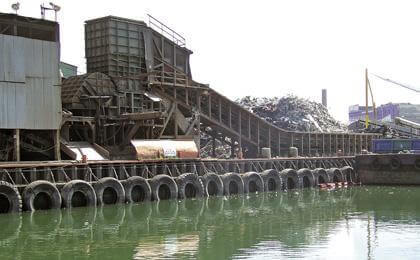By Rebecca Henely
The U.S. Environmental Protection Agency designated the 3.8-mile Newtown Creek along the southwest Queens-Brooklyn border as a Superfund cleanup site Monday, a move praised by elected officials and community activists.
“This is welcome, albeit long overdue, news,” U.S. Rep. Anthony Weiner (D-Forest Hills) said in a statement. “The parties responsible for this environmental tragedy have lagged in their clean-up responsibilities while the health and safety of Newtown Creek’s residents hang in the balance.”
The creek, which stretches from the East River on the southwest side of Long Island City to Metropolitan Avenue in West Maspeth, has a long history of pollution. In the mid-1800s, the creek was an industrial center, with more than 40 facilities operating along the creek’s sides, including oil, petrochemical and lumber industries, the EPA said. The creek was also used as a raw sewage dumping site beginning in 1856.
In addition, the waterway has suffered oil spills. In 1978, a U.S. Coast Guard helicopter discovered an oil plume underwater, which is thought to be the result of a spill begun between 50 and more than 100 years ago. This spill is estimated at 17 million gallons of oil, 6 million more than the 1989 ExxonValdez spill in Alaska, which was formerly the largest spill in America before the estimated 180 million gallon BP oil spill this summer.
The state Department of Environmental Conservation did a study of the creek in 1990 and began some cleanup efforts. Numerous companies have been named as responsible parties over the years, and in 2007 state Attorney General Andrew Cuomo filed a suit against ExxonMobil to clean the site.
ExxonMobil is still named as one of the responsible parties, as are Phelps Dodge Refining Corp., Texaco, National Grid, ExxonMobil and BP — which still has a site at the creek. Sam Ostrow, spokesman for the five companies, which are operating under the name Newtown Creek Companies, said the cleanup was turned over to the EPA in January 2009, when the project was deemed too large and complicated for the state to handle.
U.S. Rep. Carolyn Maloney (D-Astoria) praised the decision and that companies designated as responsible for the spill would be cleaning the site.
“Restoring the health of Newtown Creek will give residents of western Queens improved access to the waterfront and make the neighborhood a safer place to live,” Maloney said. “I am also heartened by reports that the costs of the cleanup are expected to be borne by large corporations, rather than by small businesses in the neighborhood.”
John Senn, spokesman for EPA Region 2, said the Newtown Creek Cos. and the city are potentially responsible parties, but more will be identified as responsible if need be. He said there is no timetable for cleanup at this point.
Phillip Musegaas, Hudson River program director at the New York clean water advocacy group Riverkeeper, said his organization has been lobbying for creek cleanup since 2002, when it conducted a study of the site. Riverkeeper filed a lawsuit against ExxonMobil for polluting the creek and lost in 2004, but had gathered support as a result. Musegaas said both Weiner and U.S. Rep. Nydia Velazquez (D-Ridgewood) wrote letters to the EPA to designate the creek as a Superfund site.
“Today’s announcement brings us closer to a healthier environment for New Yorkers in Queens and Brooklyn,” Velazquez said in a statement. “As the clean-up process gets underway, I will continue working with the EPA to ensure it proceeds safely and swiftly.”
The EPA began taking samples of the area in 2009. Samples from the sediment and surface water revealed evidence of pesticides, metals and polychlorinated biphenyls — toxic and organic pollutants often used as fluids transformers, capacitators and coolant. The EPA also found volatile organic compounds — contaminants that can evaporate into the air — in the creek.
During the Superfund cleanup, a study will be done to determine the size and scale of the contamination, cleanup alternatives will be designated and after plans are formulated the cleanup will begin. The site must be evaluated and long-term protection plans will be implemented before the site can be removed from the Superfund list. The list currently includes 1,282 sites across the country, the EPA said.
Ostrow said the Newtown Creek Cos. are already working on the study to determine the creek’s contamination.
“We had been working toward this anyway,” Ostrow said. “The fact that it’s listed doesn’t change anything.”
Reach reporter Rebecca Henely by e-mail at rhenely@cnglocal.com or by phone at 718-260-4564.



































